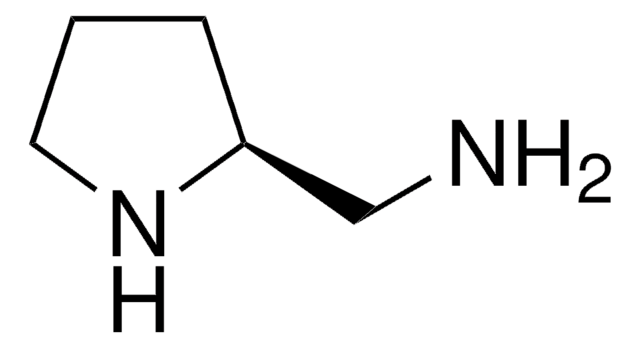139505
2-(2-Aminoethyl)-1-methylpyrrolidine
97%
Sinonimo/i:
1-Methyl-2-(2-aminoethyl)pyrrolidine, 1-Methyl-2-pyrrolidineethanamine, 2-(1-Methyl-2-pyrrolidinyl)ethanamine, 2-(1-Methyl-2-pyrrolidinyl)ethylamine, 2-(1-Methylpyrrolidin-2-yl)ethan-1-amine, 2-(1-Methylpyrrolidin-2-yl)ethylamine, 2-(2-Aminoethyl)-1-methylpyrrolidine, 2-(N-Methylpyrrolidin-2-yl)ethylamine, N-Methyl-2-(2-aminoethyl)pyrrolidine
About This Item
Prodotti consigliati
Livello qualitativo
Saggio
97%
Stato
liquid
Indice di rifrazione
n20/D 1.4684 (lit.)
Densità
0.885 g/mL at 25 °C (lit.)
Gruppo funzionale
amine
Stringa SMILE
CN1CCCC1CCN
InChI
1S/C7H16N2/c1-9-6-2-3-7(9)4-5-8/h7H,2-6,8H2,1H3
PNHGJPJOMCXSKN-UHFFFAOYSA-N
Categorie correlate
Descrizione generale
Applicazioni
Avvertenze
Danger
Indicazioni di pericolo
Consigli di prudenza
Classi di pericolo
Acute Tox. 4 Oral - Eye Dam. 1 - Skin Irrit. 2 - STOT SE 3
Organi bersaglio
Respiratory system
Codice della classe di stoccaggio
10 - Combustible liquids
Classe di pericolosità dell'acqua (WGK)
WGK 2
Punto d’infiammabilità (°F)
149.0 °F - closed cup
Punto d’infiammabilità (°C)
65 °C - closed cup
Dispositivi di protezione individuale
Eyeshields, Faceshields, Gloves, type ABEK (EN14387) respirator filter
Scegli una delle versioni più recenti:
Possiedi già questo prodotto?
I documenti relativi ai prodotti acquistati recentemente sono disponibili nell’Archivio dei documenti.
Il team dei nostri ricercatori vanta grande esperienza in tutte le aree della ricerca quali Life Science, scienza dei materiali, sintesi chimica, cromatografia, discipline analitiche, ecc..
Contatta l'Assistenza Tecnica.









